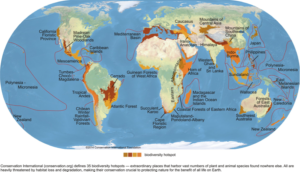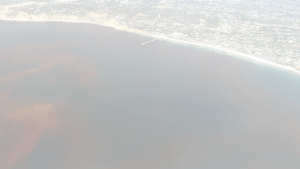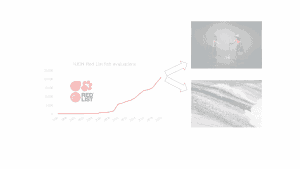Why do plants and animals live where they do? For example, how is it that marsupials only live in Australia and lemurs can only be found in Madagascar? Why and where do new species appear and go extinct? Biogeography is the scientific discipline that seeks to answer these questions. Knowing how and where species evolved is crucial to understand which areas of the planet have been historically more involved in the generation and preservation of biodiversity. Understanding how biodiversity is generated can help us to decide which regions of the planet we should aim to best protect from pollution and deforestation.
As we all know, plants and animals are not uniformly distributed on Earth. For example, tropical forests are teeming with a multitude of beetles, lianas or birds, while the Poles are much harsher environments where only finely adapted species (like polar bears or penguins) can survive. The idea that species diversity increases towards the Equator was first described by scientific expeditioners in the 19th century (like Von Humboldt or Wallace, who also went on to propose the Theory of Evolution along with Darwin). However, it is also obvious that the number of species does not only decrease with latitude, as there are areas at similar latitudes that have extremely different levels of species diversity. Therefore, animals and plants are more abundant towards the tropics, but there are some pockets of extremely high biodiversity scattered around the globe and not necessarily close to the Equator. These pockets, formally described as “biodiversity hotspots”, represent 20% of the land surface but hold more than half of all the species in the world (Myers et al). Biodiversity hotspots comprise 35 regions in the five continents and include megadiverse regions like the Tropical Andes, the Mediterranean Basin or the Cape Region in South Africa.

Fig.1 Map of the 35 biodiversity hotspots. (Image from Wikimedia Commons, CC-BY-SA 4.0 license)
Protecting biodiversity hotspots is fundamental for preserving most of the animal and plant life on Earth. But how did these particular places come to be hotspots of biodiversity? How was their astounding species richness created? This is what Andrew Tanentzap and myself, from the University of Cambridge, set out to answer. There are at least three possible scenarios or “routes” that a region may follow to become a biodiversity hotspot: a region can have lots of species because it generates species at faster rates than nearby areas, or because they import species from their surroundings at faster rates (that is, they attract species), or simply because they are older and so had more time to accumulate diversity. In a study published on February 2019 in Science Advances (Igea et al), we analysed the global geographical distributions and the evolutionary relationships of almost all the world’s mammals (5,302 species) and birds (11,093 species). This allowed us to reconstruct the rates of species generation and migration of biodiversity hotspots and their surrounding regions in all continents. We found two contrasting explanations for the high species diversity in biodiversity hotspots depending on their location. According to our results, hotspots in tropical areas have higher rates of species generation than their surrounding regions while hotspots in temperate areas (that is, far away from the tropics) imported species from their surroundings at faster rates. We also found that hotspots were generally warmer and rainier and had greater changes in altitude and habitats when compared to nearby areas with less biodiversity. This higher complexity and variability may explain how hotspots can hold and generate larger number of animals and plants.
Unfortunately, biodiversity is now disappearing at a much faster rate than almost at any other time in the history of Earth (Ceballos et al 2015). We are now in the midst of the so-called “sixth extinction” (the fifth extinction was the Cretaceous-Tertiary event when dinosaurs went extinct). There is no doubt that human-induced transformation of natural habitats and climate change are to blame for this sudden increase in extinction of life. It is therefore critical to understand which areas of the planet are particularly worth protecting because they hold most of the biodiversity. Knowing how these areas came to be so diverse could help us understand how they might respond to present and future environmental changes.
References
Myers, N., Mittermeier, R. A., Mittermeier, C. G., Da Fonseca, G. A., and Kent, J. (2000). Biodiversity hotspots for conservation priorities. Nature, 403(6772), 853.
Igea, J., and Tanentzap, A.J.T. Multiple macroevolutionary routes to becoming a biodiversity hotspot. Science Advances, 5(2), eaau8067.
Ceballos, G., Ehrlich, P. R., Barnosky, A. D., García, A., Pringle, R. M., and Palmer, T. M. (2015). Accelerated modern human–induced species losses: Entering the sixth mass extinction. Science Advances, 1(5), e1400253.
Post by Dr Javier Igea. Postdoctoral researcher, University of Cambridge. SRUK constituency of Cambridge.






